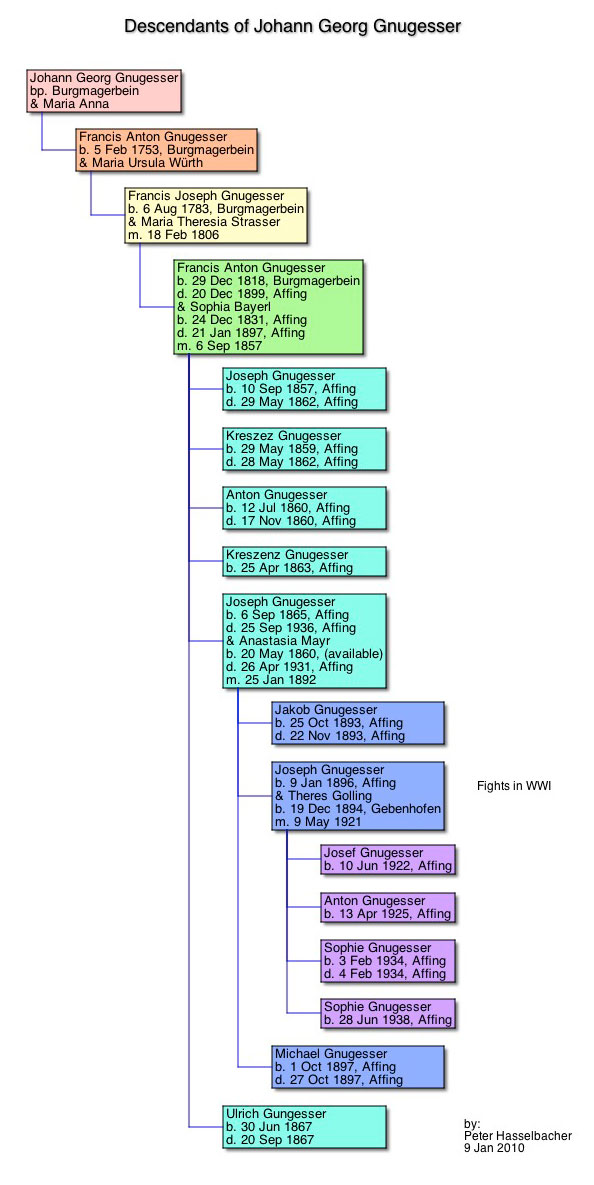I became interested in this family when I saw that in his old age, my GGG-Grandfather Leonhard Bayerl lived with his daughter Sophia and her husband Anton Gnugesser. I had hoped to find a modern Gnugesser descendant who might still have some information about the family in Affing. I sent some letters to 10 Gnugessers who I found in the phone book and who still lived in the area. Alas, I have not yet found a modern Gnugesser of Affing descent, but I have made contact with a few Gnugessers in the general area of Augsburg. It was one of those who translated and identified for me the birthplace of Anton (who was the first Gnugesser in Affing) as the village of Burgmagerbein. This small village is just north of the Danube about 65 km northwest of Affing. It appears to be the ancestral heartland of the Gnugessers. It might even be that all Gnugessers in Germany come from this area! One of my new friends suggested that the nearby church in Deggingen would have held the records of Burgmagerbein. Luckily microfilm was available through the auspices of the Church of Latter-day Saints, and I am currently perusing it.
Although I was looking for my Anton Gnugesser and his ancestors, it was immediately apparent that there are dozens of Gnugesser names in these books. In a morning's work of scanning individual entries from 1750 to 1820 I soon found Anton’s parents, grandparents, and the names of his great grandparents. I will present that material here but leave further heavy lifting for others to do. I expect to receive another microfilm containing the family registers prepared by the contemporary priests. That should make the job easier. I am prepared to share images of all the records with any Gnugesser descendant who is willing to help.
The Gnugessers in this initial 70 year period lived in the villages of: Burgmagerbein, Leitenhof, Reimertshof, Stillnau, Hochdorf, Kesselosthiem, Ziswingen and Merzingen. (I use the modern spelling of these villages.) Almost all are farmers or small farmers. Anton's father Francis Joseph Gnugesser had at least 9 children with his wife Maria Theresia Strasser. I initially thought this was Fr. Joseph's second marriage as there is an earlier Francis Joseph in the same village married to Maria Anna Raush. However, the ages don’t make sense yet. Further study is required for me to tie together the dozens of Gnugessers in the core villages. I know from other Gnugessers that some lived further south, closer to the Danube than the villages and farms above. However, their records seem to have been kept in another church. For starters, here is a straight-line ancestry of Anton of Affing with links to images of the original records.
Place your cursor over the boxes below to identify links to individual records.

Here is another temporary navagation menu:
- Anton of Affing
- Francis Joseph- father
- Francis Anton- grandfather
- Johann Georg- great-grandfather
Comments and Questions:
Latinized names:
These church records were written in Latin. The given names were "Latinized." I made educated guesses what the individuals might have been called in the real world but would appreciate more seasoned opinions. For example, I interpret that Antonious would have been Anton in vernacular German. Many of the men were given an initial Latin religious name that I translate to "Francis." Would they have been called Franz? At least one was. I assume that most would have been known and called by their second given name as I have seen the custom to be in both northern and southern Bavaria. Thus Francis Joseph would be Joseph.
About "semicolons:"
The occupation of most of the Gnugessers is described in Latin as semicoloni as opposed to colonus. A colonus is a farmer, tenant, or tiller of the land. Initially I could not learn what the distinction is. At least one Gnugesser was called a "rustic" compatible with the fact that these Gnugessers were on the lower end of the farmer hierarchy. I suspected that a semicolonus is less prominent than a full-blooded colonus. Indeed, a week later when I was re-reading the church records of 18th Century Edenried (just 70 km to the south of Burgnmagerbien), I found the distinction used with a greater profusion. There were "semicoloni," 1/4, and even 1/8 coloni as well. It seems clear that the prefixes to colonus refer to the amount of land alloted for the farmer's use.
Military Records:
The Joseph of 1896 would have been of the age to fight in WWI. When Ancestry.com recently posted the WWI Muster Records of Bavarian soldiers, I naturally looked for Gnugessers and found three, including Joseph of Affing. Here is his record. [Pending. Ask me if you have an interest to see them.]